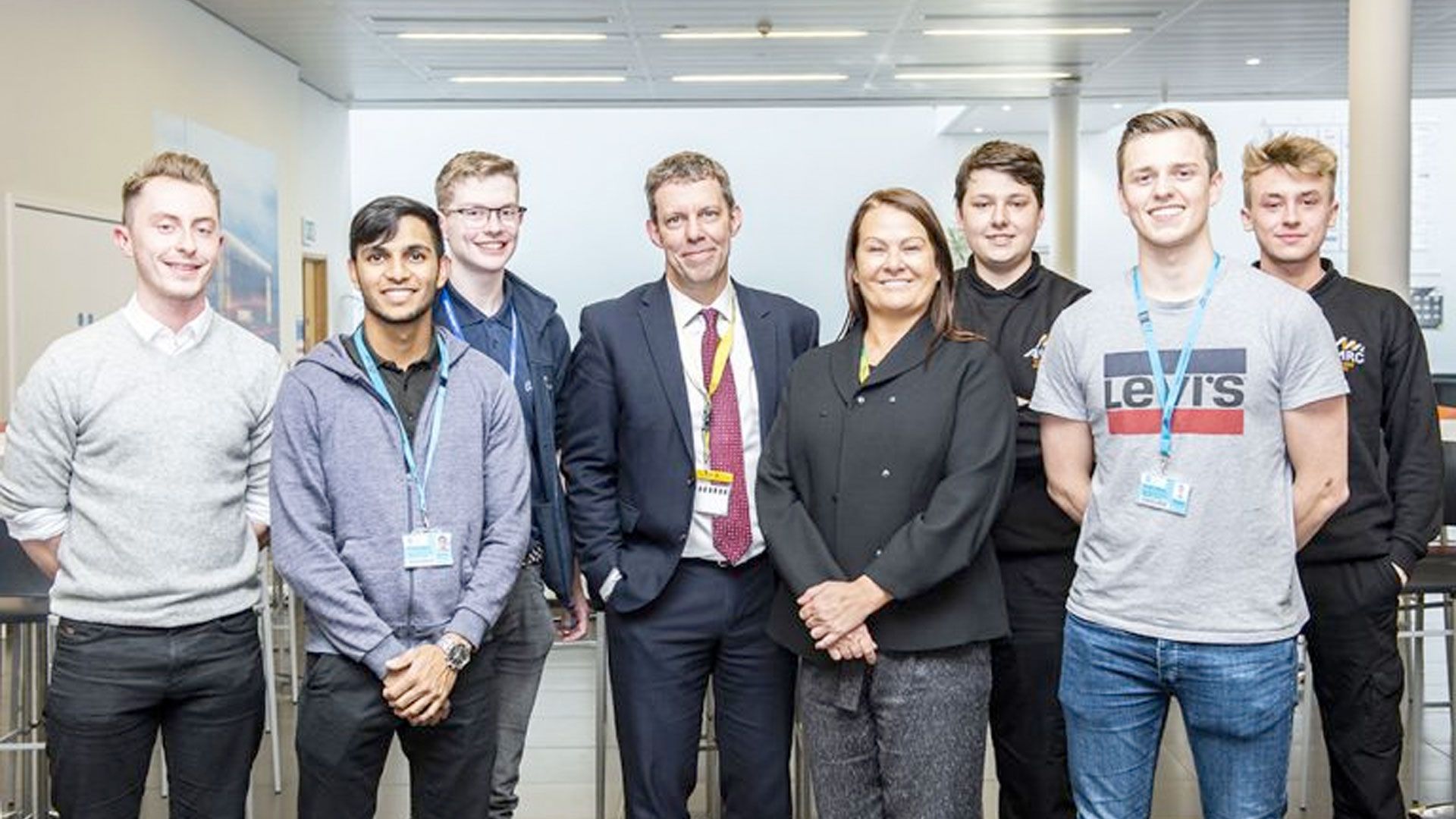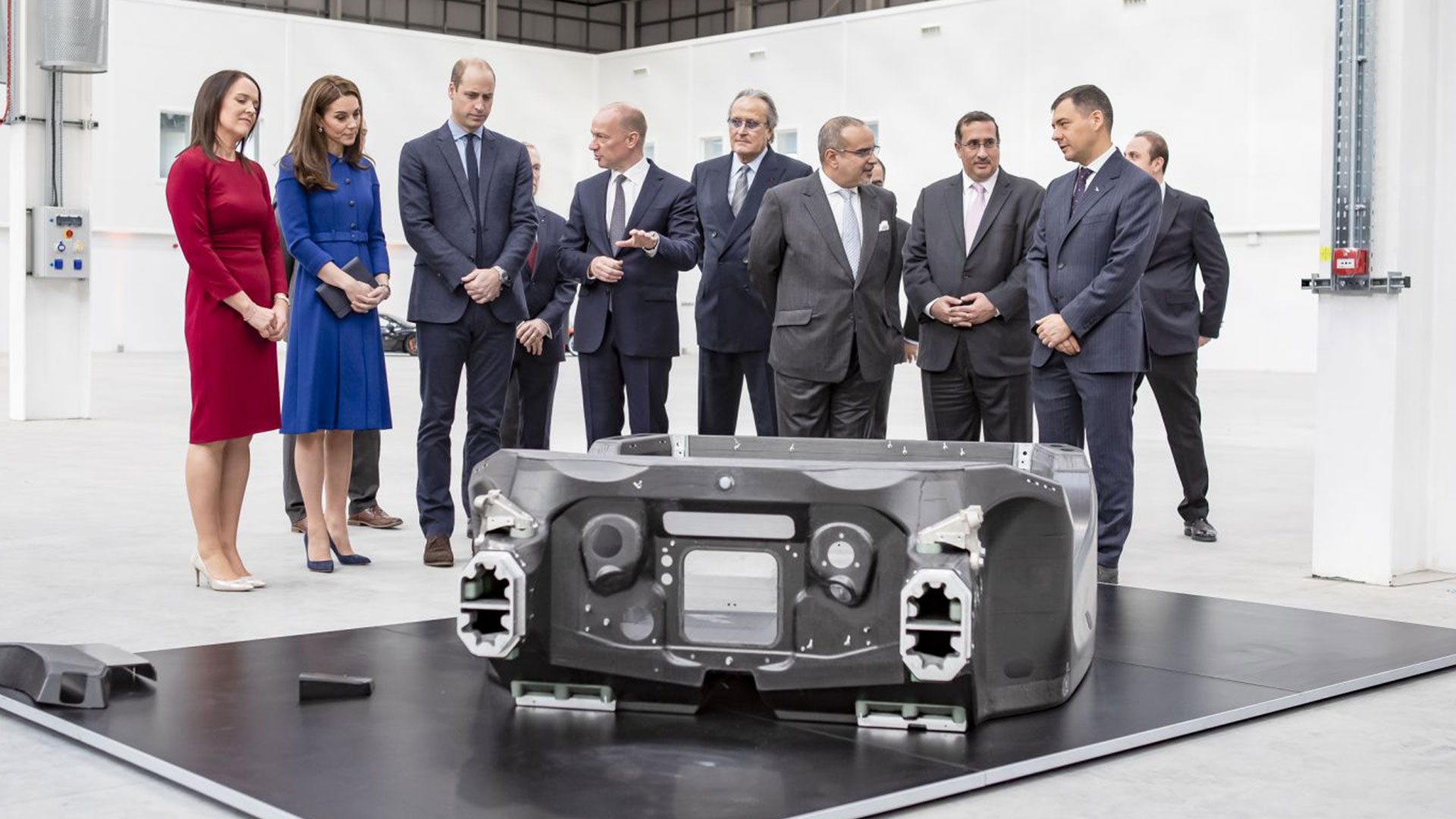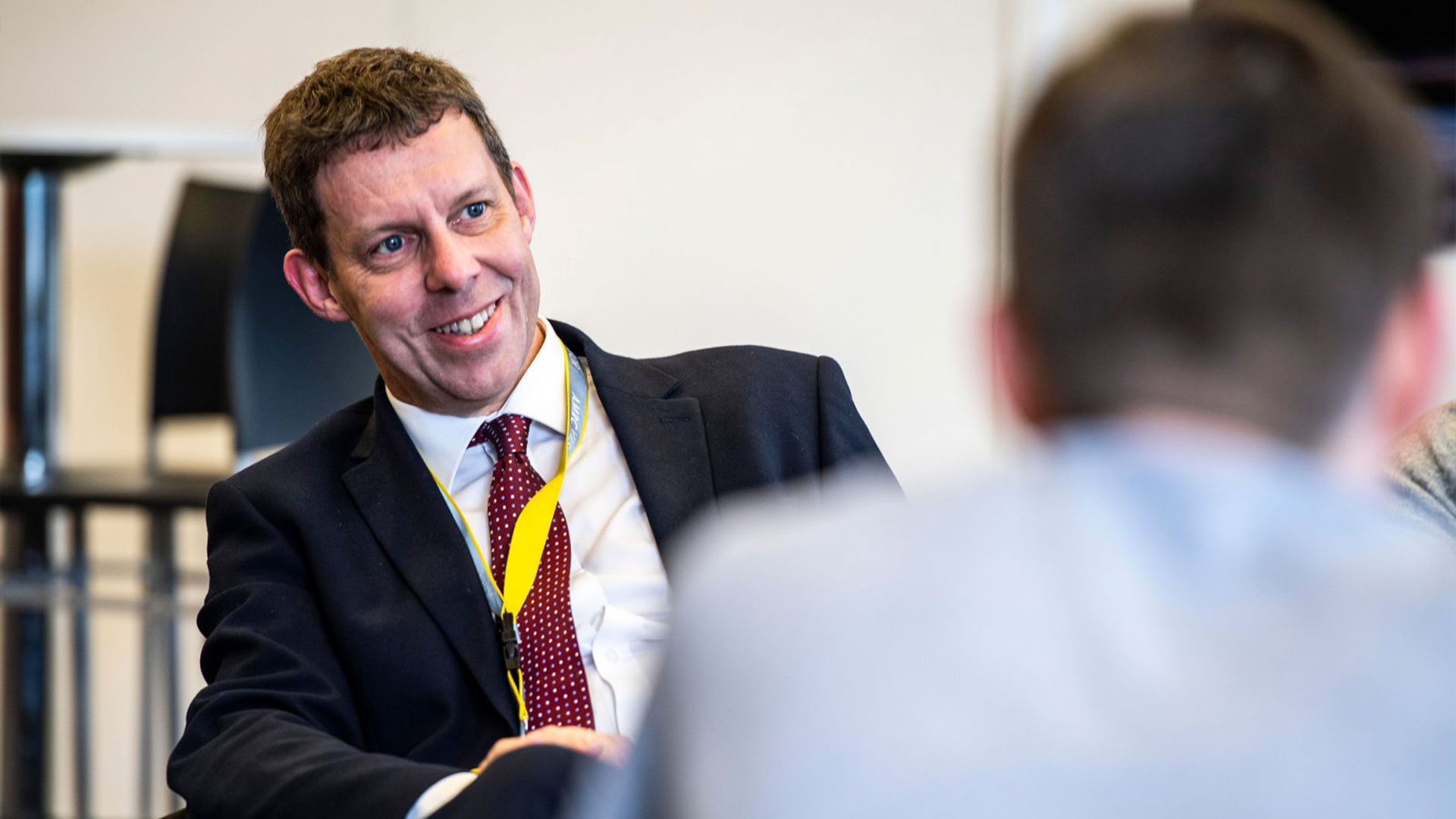2018 – The year of partnership and apprenticeship

As the New Year begins we take one last look at the highlights of 2018 and celebrate the many ways the AMRC is raising the profile and reputation of the University of Sheffield as an exemplar of how higher education partners work with industry and government to promote economic and social well-being.
It is almost a year to the day since Professor Wyn Morgan found himself sitting on a sofa in the AMRC Training Centre cafeteria, braced for questions from the Today Programme’s Justin Webb. The BBC’s flagship breakfast radio show – 7.5 million listeners tune in most mornings – had turned the centre’s gleaming meeting space into a makeshift studio for the three-hour, live outside broadcast.
Instead of apprentices queuing for bacon and egg butties, an audience of 120 academics and students had gathered to put faces to the familiar radio voices; among their number were two former Secretaries of State for Education, Lord Blunkett and Justine Greening. Professor Morgan, the University’s Vice President for Education was in good company and keen to extol the virtue of apprenticeships.

"This place is a real nexus of what the university can provide in terms of its know-how, research and knowledge – working with local and multinational companies – to provide practical solutions and ideas to improve productivity, which is one of the biggest challenges the economy faces. We are also developing the workforce to work with the new technologies, ideas and processes that this region and the economy needs," he told Webb who had earlier interviewed a number of apprentices on the training centre’s shop floor.
One of those Webb spoke to was Oliver Marsh, whose name was to feature prominently throughout 2018 as he made his way to become the Yorkshire and Humber Apprentice of the Year; a title that earned him a place in the national finals alongside eight other contenders from around the UK. Pipped to the post at the London finals in the higher apprenticeship category, Oliver has nevertheless made his mark on both his company and the region.

The British Plastics Federation Apprentice of the Year, has helped Rotherham-based MGB Plastics – one of Europe’s leading manufacturers of wheelie bins – shave a six-figure sum off its costs through improvements in productivity; brought about by the application of lean thinking to its production processes.
MGB Training Advisor Ian Cosgrove said: “The need to attract bright, enthusiastic youngsters into manufacturing has never been greater. We are extremely fortunate in having such a well-equipped and professional training provider on our door step. Working closely with the AMRC Training Centre we developed Oliver’s higher-level programme, integrating a polymer diploma to run alongside his mechanical qualification. It was refreshing to work with a team with such a ‘can do’ attitude, an attribute that is often lacking in training providers who push a ‘one size fits all’ philosophy.”
Another apprentice interviewed by Radio 4 that day was Leigh Worsdale. One of the growing number of young women who are breaking into the male-dominated world of engineering, Leigh has gone on to become an articulate ambassador for apprenticeships including demonstrating Industry 4.0 technologies to MPs at a High Value Manufacturing Catapult event at the House of Commons. “I tell people that the AMRC will give you the skills to go as far as you want to go in life. I wouldn’t be the person I am today without my apprenticeship,” said Leigh who has recently become an Operations Team Lead on the spotless, high-tech shop floor of Boeing’s £40 million production facility in Sheffield, the first of its kind in Europe.

Leigh was one of more than 30 University of Sheffield AMRC apprentices gathered in the new 6,200 square metre building when it was officially opened by the Secretary of State for Business, Energy and Industrial Strategy, Greg Clark, in what was perhaps the most memorable moment of 2018. Clark told his audience that: “Boeing choosing the heart of South Yorkshire as its first European home is testament to our capabilities, talent pool and strong manufacturing supply chains which are vital to job creation and creating value for local economies.”
Second-year machining apprentice, Roisin Chapman-Allison, 17, from Sheffield, who was also at the opening said: “I never thought when I left school at 16 that I would be operating a £500k machine for Boeing. It makes me feel really proud to be making components for the world’s best aircraft and that we are the next generation of engineers. We are the future.”
One of the founders of the AMRC, Adrian Allen, who established the first contacts with Boeing in the late 1990s, described the day as “a dream come true.” He added: “It’s been great to see so many young people from across the region who will be playing a vital role in the manufacture of Boeing airplanes. But this, I believe, is just the beginning. There is so much more we can do.”
Earlier that month, the Northern Powerhouse Minister, Jake Berry, expressed a similar sentiment when he presided over the opening of not one, but three new university research buildings next to the AMRC’s Factory 2050, declaring that “when I talk to the Prime Minister about what the North is becoming I talk to her about the Advanced Manufacturing Research Centre, a place that was built on the site of one of the most divisive and bitter industrial disputes in modern history.”
What has happened here, he added, “is a profound transformation.” More than 20-years earlier “this was the site of a British Steel coking plant that converted coal into industrial fuel. The jobs were tough. People worked long hours. They worked in hard conditions inhaling high levels of dust and other chemicals. This had a huge impact on their heath and reduced their life expectancy.
“Today, this site is home to world-class, global research facilities that have attracted international companies like Rolls-Royce, Boeing and McLaren. It has created 1700 highly skilled, highly paid jobs, many of whom are graduate engineers and PhDs from all over the world. It is a perfect example of how public private partnerships can create internationally-recognised facilities for engineering, innovation, research and manufacturing excellence, acting as a catalyst in stimulating advanced manufacturing capabilities, creating highly skilled and high paid jobs.”
It was for this reason that two major all-party Parliamentary Committees visited the AMRC and its Training Centre in 2018 to better understand how this ‘win, win, win’ model of higher education, industry and government collaboration, might be exported to other parts of the country.
First, Leeds MP Rachel Reeves brought her Business, Energy and Industrial Strategy committee to the AMRC. This provoked a valuable discussion on the under-representation of women in engineering and convinced us to expand and accelerate our Athena Swan and STEM work, taking on a dedicated STEM team to change perceptions of engineering in the region’s schools and open opportunities for harder to reach communities.
Professor Paul Walton, who helped secure Gold Athena Swan status for the University of York’s Department of Chemistry, gave an inspiring talk to a packed KTC warning that ‘overcoming discrimination against women in engineering was a marathon not a sprint.’ And Green Party Lord Mayor of Sheffield, Magid Magid, also joined forces with the AMRC to support our STEM activities in the city’s ethnically diverse primary and secondary schools.
Later in the year, Robert Halfon MP made the AMRC Training Centre the first port of call for the all-party Education Committee’s inquiry into what impact the fourth industrial revolution might have on education and society. “My two favourite words are degree apprenticeships,” Halfon told Nikki Jones, Director of the AMRC Training Centre, where he and his colleagues met young apprentices and representatives from the more than 250 small and medium sized manufacturing firms that use the apprenticeship levy to build the engineering workforce of the future.
A roundtable discussion heard from Brian Holliday, Managing Director for Siemens Digital Factory and a graduate of the CBI’s Executive Leadership Programme. Brian started his career as an apprentice with Texas Instruments and went on to read Computer Systems at Cardiff University before joining Siemens, the global leader in electrification, automation and digitalisation in 1993.
He later told the committee in Oral Evidence that: “There has to be more collaboration with business to bring real-world examples into school environments, so that pupils understand why they are learning something in schools. My concern is that if we continue to pursue a knowledge-based approach to academia we are setting our kids up increasingly to compete with computers, with devices that we all use that are now 1,000 times more capable—more powerful—than they were just 15 years ago.
“The debate we have to have is, ‘What about the primary school children today who will have devices 1,000 times more capable than these again at their fingertips to help solve things, including access to knowledge through natural language and so on?’ We have to be much more focused on developing the creativity, imagination, intuition, and emotional and ethical skills that we look for when we start to assess people for world-of-work jobs.”
Before October was out, the politicians were replaced by Royalty as the new £50 million McLaren Composites Technology Centre – built with funding support from the Sheffield City Region – was opened by the Duke and Duchess of Cambridge.

McLaren CEO, Mike Flewitt, told invited guests: “It is an important milestone for us as a ground-breaking, innovative car company and allows us to tap into the great energy, vitality and skills this part of the world has to offer. What goes on here at the MCTC will be vital for our ability to make good on our intention to continue to develop and unveil cars that are lightest in class; it is my belief that Britain – through facilities like this – can become a world leader in lightweight materials technology that will help create more efficient future vehicles.
"We are proud to be bringing new jobs to the Sheffield region which has a long association with advanced materials; first with steel and now a future to look forward to with carbon fibre innovation and production for McLaren."

The new President and Vice-Chancellor of the University, Professor Koen Lamberts praised the role of the AMRC and its research team in bringing McLaren to the region adding: “This new centre is a cause for celebration for our region, the North of England and the UK as a whole. Just yards away from McLaren’s new centre we have the AMRC Training Centre, which is training McLaren’s first degree apprentices in the Sheffield City Region. Offering these specialised apprenticeships is helping to ensure that our region has the right skills and knowledge to drive the manufacturing workforce of the future.”
Keith Ridgway, the AMRC’s Executive Dean AMRC, said: “Our partnership with McLaren will help develop synergies between future powertrain development and the clever use of lighter materials to save weight and reduce the energy needed to power them. If the UK is to win the weight race, industry and government and universities must continue to work closely to ensure we make the most of what Composites UK estimate to be a £12 billion market by 2030. That’s why we continue to invest significantly in our lightweighting capability.”
During 2018, with the support of major funding from the Aerospace Technology Institute (ATI) we installed the largest robotic triaxial radial braider in the UK, which has widespread applications for making components used in aerospace and automotive. Our lightweighting team now has a 3D loom to accompany other new equipment which will be used to manufacture preforms and develop the enabling technology for commercialisation including joining, automation and impregnation: this includes the 1000T Rhodes press and KraussMaffei RTM, tailored fibre placement, a high temperature-high tension filament winder, stitching robot, tow-spreading machine and robotic end effectors for automated handling.
Professor Ridgway added: “Thanks to the support of government through the ATI, the AMRC now has the technology and the research talent in depth to support UK industry in winning the weight race which is essential as we make the transition to a low carbon economy by supporting the shift to electric cars, trucks and, eventually, aircraft. All we need now is a dedicated, purpose built lightweighting centre to house the new machinery which is currently scattered across the campus as we try to juggle people and kit in response to the ever-increasing industrial demand for our expertise in novel materials and processes.”
Another highlight of 2018 was a visit to Factory 2050 by Professor Fei-Fei Li, director of the Stanford Artificial Intelligence Lab (SAIL) and, at the time, the Chief Scientist for Google AI and Machine Learning. Flying in from Silicon Valley to see the work our researchers were doing with AI and manufacturing, Professor Li was intrigued by the way the AMRC was combining skills and talent development – from apprenticeships to post-doctoral research – along with the digital technologies that could massively disrupt the world of work and the wider society.
Professor Li, the researcher who built ImageNet, is one of the small group of scientists who are responsible for AI’s recent remarkable advances. This privileged position has made her acutely aware of the inherent bias in AI and of the urgent need to make fundamental changes to how AI is engineered — and who engineers it. In recent evidence to the US House Committee on Science, Space, and Technology on Capitol Hill she told Congressmen and women: “With proper guidance AI will make life better. But without it, the technology stands to widen the wealth divide even further, make tech even more exclusive, and reinforce biases we’ve spent generations trying to overcome.”
In the light of this, it was gratifying that on her whistle stop tour of Factory 2050 one of the world’s leaders in human-centred AI should declare that she was “blown away by my visit to the University of Sheffield. Their Advanced Manufacturing Research Centre combines the creation of local jobs beautifully with robotics and AI innovation for industry. It is a pioneering and visionary model for the future of academic-industry collaborations.”
Which brings us to our final high point of 2018 and full circle since it involves Silicon Valley, Stanford, the AMRC Training Centre and Attercliffe – the birthplace of the idea of the Advanced Manufacturing Research Centre.
Late last year, a retired Silicon Valley CEO called out of the blue to say he would like to make a donation to the AMRC Training Centre. Ever since it had opened in 2014 he had been following its progress from across the water. What made it special to him was that he was born in Attercliffe and, as a young boy, had played in the spoil heaps around what was once the Orgreave coking plant, the site on which the Training Centre is built and hopes to expand.
His story, which we will learn more of in the coming year, is one of triumph over adversity. It involves turning down a place at Cambridge in favour of a 1-3-1 student apprenticeship at AERE Harwell with a degree in Production Engineering at a northern university. This was followed by two higher degrees and then a post-doctoral fellowship at Stanford University.
Now retired after a 30-year career in the precision engineering industry, and with no children of his own, he would like to put something back into the region that made him. And what better way than to support the next generation of engineering apprentices. “It was an apprenticeship that changed my life,” he said. And now his donation will ensure that apprenticeships in Sheffield continue to change lives for good for decades to come.
